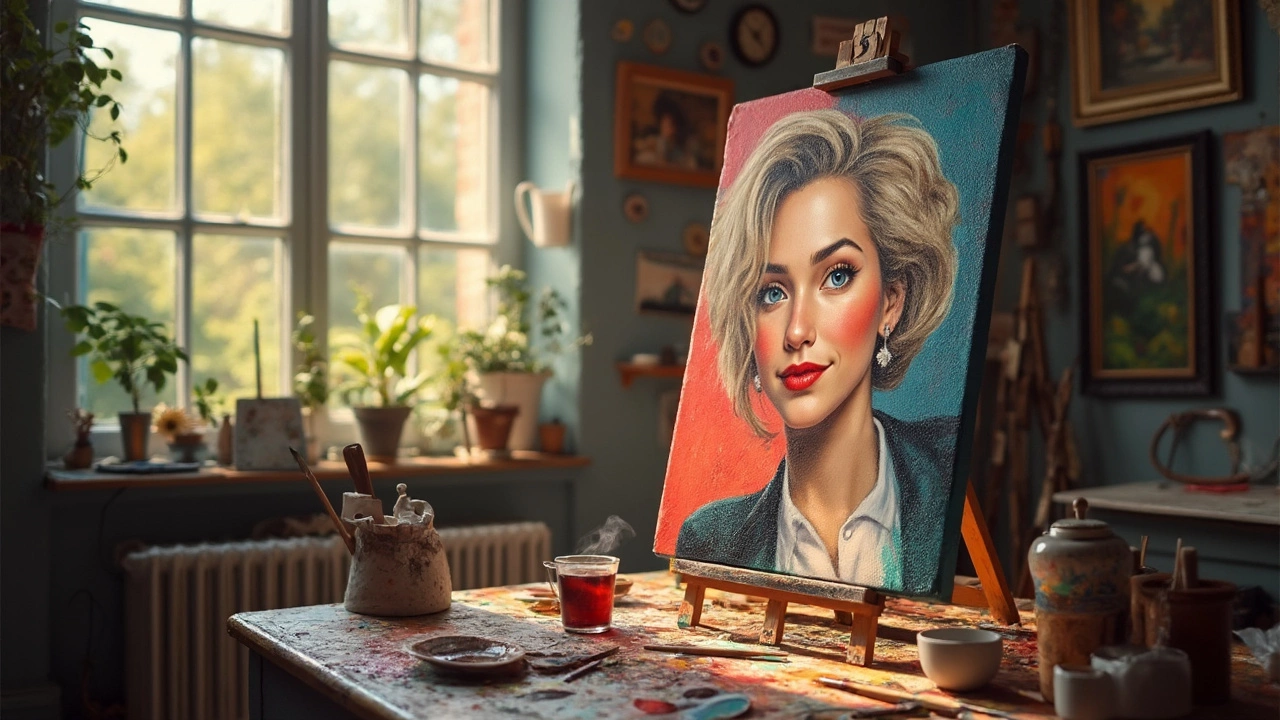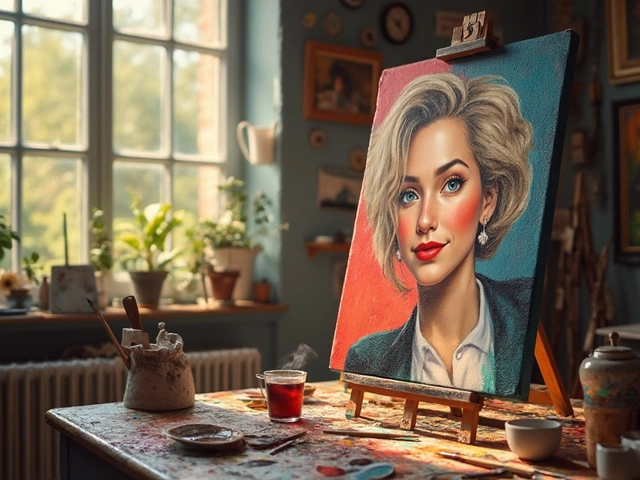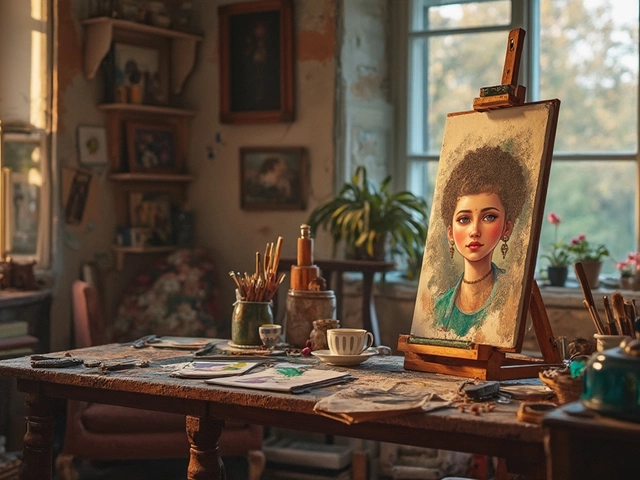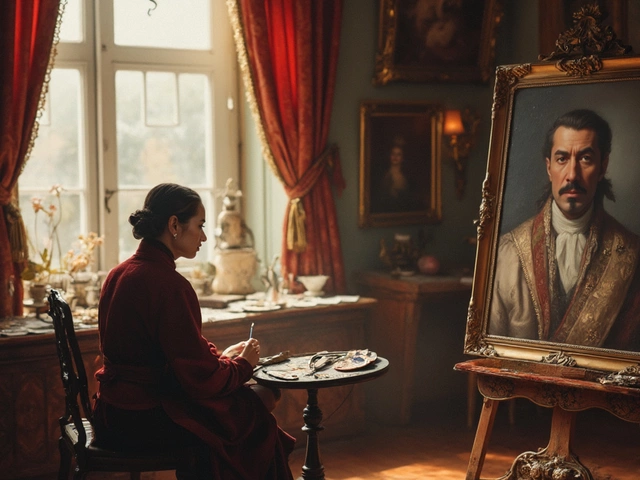Ever found yourself standing in an art supply store, staring at a wall of paints, and wondering, 'Should I go with acrylic or oil for this portrait?' You're not alone. Both have their perks (and quirks), and picking the right one can make a world of difference in your painting journey.
First off, let's talk drying time. Acrylics are the speedsters of the art world, drying fast enough to keep you on your toes. This can be a dream or a nightmare, depending on how quickly you work. Oils, on the other hand, take their sweet time to dry. This gives you plenty of room to fix mistakes and fiddle with textures until they look just right.
Then there's the blending game. Oils are like that smooth jazz band, effortlessly mixing and mingling, letting you craft those subtle shifts and gradients with ease. Acrylics, though more of a rock band with their bold, punchy strokes, require a bit more finesse when it comes to blending. But hey, with practice, they can kick out some amazing harmonies too.
- The Basics: Acrylics and Oils
- Drying Time: A Big Difference
- Blending and Layering Techniques
- Color Intensity and Texture
- Cost and Availability
- Choosing What Suits You Best
The Basics: Acrylics and Oils
Diving into the world of portrait painting, you’ll quickly encounter the age-old debate: acrylic painting vs. oil painting. Both types of paint have their own unique characteristics and quirks that make them appealing in different ways.
Acrylics, born in the modern age, are a bit of a rebel. They are water-based, meaning they can be thinned and cleaned up easily with water—a huge plus for those who don't fancy the smell of turpentine. They also dry fast, which is great if you're on a deadline or enjoy working in layers, as it lets you build up textures quickly. Because of this quick-drying nature, though, they can be a little unforgiving if you like to ponder your brushstrokes.
On the flip side, oils are the classic choice for many painters. Rich, buttery, and slow-drying, they offer a level of depth and luminosity that's hard to match. Their main draw is the extended drying time, allowing for smooth blending and gradual transitions. This makes oils a favorite for those who love to play around with colors and textures, bringing a portrait to life with subtle nuances.
For someone starting out, understanding these differences is key. Acrylics might seem easier due to their water-based nature and quick drying, but oils offer more flexibility in terms of technique. It really comes down to your style and what you're comfortable with. Either way, both mediums can produce stunning portraits with practice.
Here's a quick rundown:
- Acrylic painting: Fast-drying, easy cleanup, suited for quick layers and textures.
- Oil painting: Slow-drying, great for blending, offers deep, vibrant colors over time.
Each medium has its place, and often the best way to find what works for you is to try both and see where your creativity flows.
Drying Time: A Big Difference
When it comes to choosing between acrylic painting and oil painting for your portrait, drying time can be a game-changer. Let's be honest: it's often make or break for many artists. Acrylics dry super fast – we're talking minutes here. This is perfect if you're the kind of person who likes to see results, like, yesterday. You can quickly layer, adjust, and move on without the hassle of long waiting.
On the flip side, we've got oils, which are notorious for taking their sweet time. Typically, they can take between 1 and 2 weeks to touch-dry, which is a blessing for anyone who loves to mull over details and dive into deep blending. Some artists say you can actually work on an oil painting over a whole month without any problems. It's basically the chill option if you don't mind hanging out with your art piece for a bit longer.
So, here's the thing: if you're racing against the clock or working on a tight schedule, acrylics are your best friend. But if you're in for the long haul with a side of rich texture and deep nuances, oils might be your go-to.
Ultimately, it boils down to your personal style and how you like to tackle the painting process. Just remember, both types have their unique rhythm, and mastering them will make your portrait painting a whole lot more fun.
Blending and Layering Techniques
When it comes to acrylic painting and oil painting, each offers a unique experience in blending and layering, which is crucial for portrait artists striving for depth and realism.
Oil painting excels in blending due to its slow-drying nature. This means you can mix colors directly on the canvas over several days, achieving those smooth gradients and subtle transitions in skin tones or hair. The secret sauce here is the 'wet-on-wet' technique, where layers are built while the previous one is still wet, allowing for seamless color transitions.
A lot of portrait artists swear by using a 'fat over lean' method with oils. This means starting with thinner paint layers and gradually building up to thicker ones. It helps prevent cracking as the paint cures. You can experiment with glazing, which involves applying a thin, transparent layer of oil paint to alter the colors beneath. It's like adding a tint to your portrait, enriching the color without losing the details underneath.
Now let's look at acrylics. These dry fast, which means you have less time to blend directly on the canvas. But don't count them out just yet! You can use acrylic retarders to slow down drying time, giving you a bit more flexibility. Layering with acrylics can create dynamic effects. Many artists use a 'scumbling' technique, where dry paint is applied over a dry layer to create a textured, softer look.
If you like detail, acrylics might be your match—they layer up like a boss with clear, distinct shades. You can easily build up layers for shadows and highlights, giving your portrait a sense of volume.
For both mediums, a good blending brush can be your best friend. And remember, practice makes perfect! Try out different techniques and see what brings your portraits to life the best.
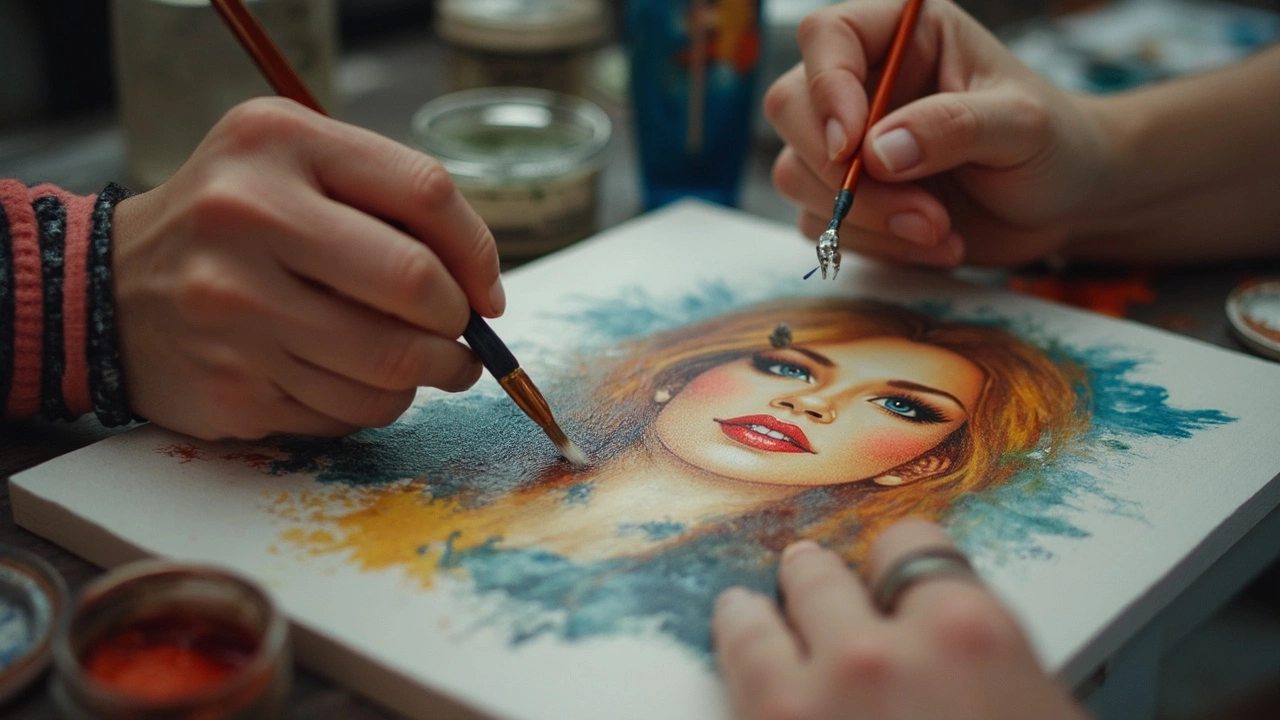
Color Intensity and Texture
When it comes to color intensity and texture, oil and acrylic paints are like night and day. It's not just about which one shines brighter; it's about how they feel and look on the canvas.
Oils are the heavyweight champs in the vibrancy department. Their color richness is hard to beat, probably because oil paints hold more pigment. This means they’re great for achieving deep, luxe hues that stick around even after drying. You want bold, punchy portraits with smooth blends that pop? Oils have got your back.
As for texture, oil paints are super flexible. They let you build layers upon layers, creating a depth that jumps out at anyone looking. You can go thin or pile it on thick—oils don’t mind. They keep their texture even after they dry, which is perfect if you’re aiming for a more textured, tactile piece.
Acrylics might not be as naturally vivid, but they’re no slouches. They’re bright and bold, and if you layer them right, they can surprise you with richness. Plus, they dry quickly, which divas like in their portraits. You're looking to achieve fine details? Acrylics are perfect because they hold thin strokes well.
Another cool thing about acrylics is that they’re good at mimicking. You can tweak them with gels and mediums to make them behave more like oils or even watercolors, giving you flexibility. Need a strong texture? Add some modeling paste to your acrylics, and boom, you're in business.
Painting tips: For newbies shooting for bright color and detailed work without the wait times, acrylic could be your best friend. If you're into the classic, rich textures and don’t mind taking your time, oils might be your paint.
Cost and Availability
When it comes to cost, acrylic painting often wins the affordability contest. You don't have to break the bank to start with acrylics. They’re generally cheaper, making them a go-to choice for beginners or anyone on a budget. Plus, you don't need as many specialized supplies to get started. Basic brushes and a canvas are enough to get your creative juices flowing.
Oil painting can be a bit of a wallet warrior, and here's why. While the initial cost for paints might not be exorbitant, you have to consider the extras. You'll likely need more expensive brushes, a range of mediums for diluting and cleaning, and a decent primer for your canvas. It all adds up, especially when you're after high-quality outcomes.
Now let's talk availability. Acrylics are pretty much everywhere. From small hobby shops to big art stores, you'll find a wide selection. Oils aren't trailing far behind, but certain colors or brands might be less available, especially the higher-end options. If you're hunting for some niche, professional-grade oil paints, you might have to shop online or in specialized stores.
To make things clearer, here's a quick comparison:
| Factor | Acrylics | Oils |
|---|---|---|
| Initial Cost | Low | Medium to High |
| Ongoing Expenses | Low | Medium |
| Availability | High | Moderate |
If you're just dipping your toes in, starting with acrylics might be less intimidating both financially and in terms of availability. But if you’re up for spending a bit more and diving deep into the rich world of oils, the extra investment can be totally worth it in the long run.
Choosing What Suits You Best
When it comes to picking between acrylic painting and oil painting, it really boils down to what fits your style and workflow. Are you someone who likes to work fast and finish what you started without waiting forever? Acrylic might be your buddy then. Its quick-drying nature means you can layer up faster, achieving depth and dimension in record time. Perfect for those who like a snappy process with less mess.
But if you're more into taking your time—a bit like a chill afternoon sipping tea—then oils are calling your name. They offer flexibility, allowing you plenty of time to mix and adjust as you go. Those who enjoy rich textures and smooth blends often find themselves reaching for oils.
Consider your work environment too. Acrylics are water-based, meaning they’re easier to clean with just water and soap. No need for harsh chemicals. This makes them a friendly option for painting indoors without needing much ventilation. On the other hand, oils often require added mediums and solvents to clean, which means more materials to manage and potentially more cleanup hassle.
Budget can also be a deciding factor. Typically, acrylics are less expensive up front, not just in terms of paint but also in brushes and other supplies since they don’t demand the same kind of maintenance as oils. If you’re just starting out or on a tight budget, this might tip the scales in favor of acrylics.
Lastly, think of what you're planning to paint. Some artists find that acrylic's quick drying time is great for projects that involve a lot of layering or underpainting, while oils are favored for their ability to produce luminous skin tones in portraiture due to their superb blending qualities.
- If you like quick, spontaneous works, acrylic might be your best pick.
- For a slower, more contemplative approach, oil offers that extra time and blending ease.
- Consider the cleanup and environmental factors—acrylics are less demanding here.
- Budget-conscious folks may lean toward acrylics, especially starting out.
